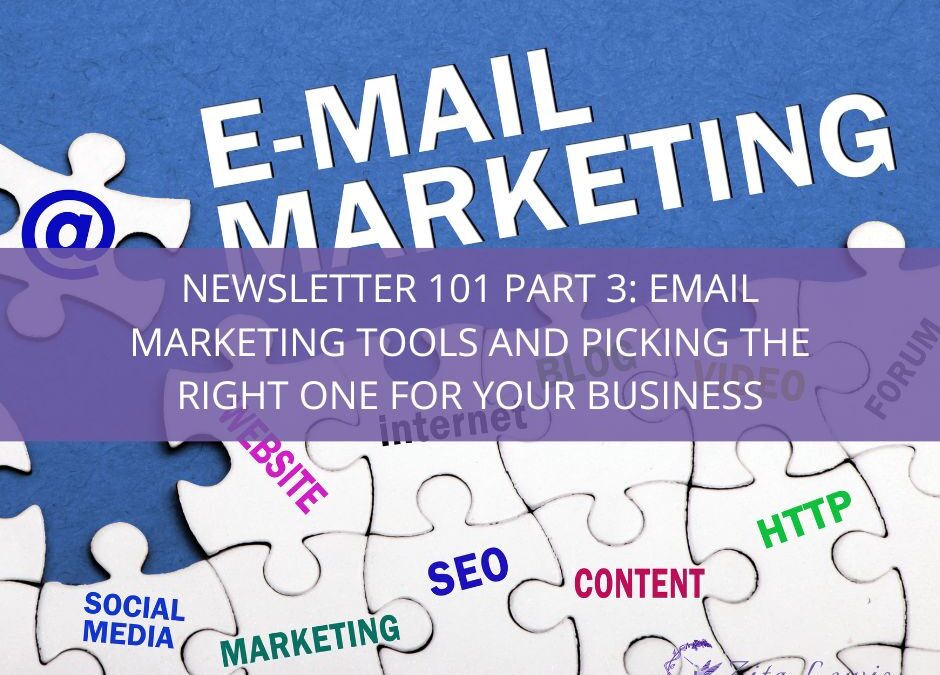As a small business owner, you want to get the most out of your email marketing efforts. In our previous two blogs in the Newsletter 101 series, we looked at how to get started with email newsletters, what should go in them and some of the reasons why your newsletters might not be getting read by your audience.
In this blog, I want to go through the technical side of things by taking a quick look at the key features and considerations you should look for when selecting an email marketing tool, and some of the popular software choices available at the moment.
What is email marketing software?
An app that allows you to create and manage mailing subscriber lists, create and send email newsletters and view the analytics of how well your emails have performed. Commonly used marketing software for small business owners include MailerLite and MailChimp. You might also hear it called an email marketing platform.
Using email marketing apps like this make it easier for you to manage your email marketing campaigns, help you to keep on the right side of GDPR and give you that much-needed performance information that you can use to improve your email marketing strategies for better results.
What do you need from your email newsletter software?
The point of using an app for your email newsletters is to save you time and energy when marketing out to your subscribers. So, the email marketing software you choose to use should be able to:
- create and manage email lists of subscribers
- design attractive emails or choose from email marketing templates
- mass mail to your list of subscribers at the time of your choosing
- provide analytics on opening, reading and clickthrough rates
Some email software will have more powerful features than this, such as A/B testing so you can test two different subject lines or designs to see which performs better, WordPress plugins to make sign-ups easier and other integrations with software you might use. These are ‘nice to have’ rather than essential email marketing features, so you need to decide whether they are worth paying the extra for if they are not freely available on your preferred email marketing platform.
MailChimp or MailerLite – which one is better for my small business?
That’s a question I’m often asked and I often find that there’s a 50/50 divide of popularity between the two. They are both very similar in what they have to offer and how they work but there are some subtle differences that might make one look more attractive to you than the other.
Mailerlite has a decent offering on its free plan which is ample for most small business users. With up to 1000 subscribers on email lists permitted and 12,000 emails per month, it’s unlikely you’re going to be exceeding those limits anytime soon. Mailerlite also has automated features like -, the ability to create landing pages and analytics reports so you can find out how well your email newsletters are really hitting the mark with your audience.
You do get full email support with MailerLite which is always useful to have if you encounter an issue and if you do want some more advanced features or have more than 1000 subscribers, the paid plans start from just $10 a month which is affordable.
MailChimp is one of the most well-known email marketing apps out there but its free plan is much more limited than with Mailerlite, with just 500 subscribers on contact lists permitted and 2500 monthly emails. Its automated features are now only available on its paid plans (they were free at one time).
There are two downsides to using MailChimp for me – you only get email support for the first 30 days after you’ve signed up, beyond this point you’ll need to ask on the forums or search Google for assistance. The other issue is that on every email you send there is a small Mailchimp Ad banner which may affect the aesthetic feel of your emails. The paid plans on Mailchimp start from $11 for more than 500 subscribers and sending 500,000 emails a month but if you want more advanced features there is a jump up to $17 a month.
Other email marketing software exists such as Sender and Zoho. Check out this article for a summary of the different apps available and their pros and cons.
Try out different email newsletter apps until you find the right fit for your business
We’re all different in our likes and dislikes when it comes to the software and the technology we use, just as some prefer macs over windows, you’ll probably find that a certain email service provider works better for you than another.
My best advice is to sign up for the free accounts, check out the key features and capabilities of them all and try sending a few emails to see how things go. Alternatively, if the idea of setting up software like this for an email campaign fills you with dread, discover how I can take care of the technical side of things for you with my newsletter creation and marketing service.

